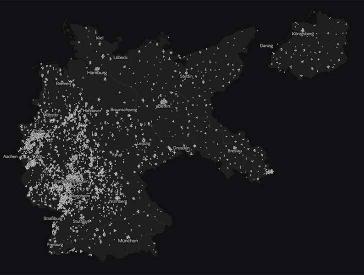JMB App
The Jewish Museum Berlin Audio Guide
The JMB app takes you not only through the core exhibition, but into the Museum Garden and also tells you about Daniel Libeskind’s striking architecture. Audios, videos, images, texts, and games convey the museum content. Are you wondering how to view the 3,000 square meter core exhibition in a single visit? The JMB app offers highlights and architecture tours. Choose a tour based on how much time you have and follow our directions to guide you through the museum. Alternatively, you can stroll around freely and select specific items from over 100 stations. And if you you’re not sure where you are, an interactive map offers orientation.
Download JMB App
We offer the app in eight languages: German, German Sign Language, English, French, Italian, Spanish, Hebrew and Russian. The highlights tour is also available in Leichte Sprache (German plain language).
We recommend installing the app on your phone before your visit and streaming the contents while in the museum. Remember to bring your headphones and charge your smartphone battery before your visit.
 X
X
In addition to audio content, you can read texts, play games, and view videos and pictures in the app; Jewish Museum Berlin, graphics: Verena Blöchl, NOUSdigital
Borrow an Audio Guide at the Museum
For a fee, you can also borrow a device to use the JMB app on. Please pay at the ticket corner.
An App with an Inclusive Approach
We have developed accessible options in the JMB app for visitors with visual impairments, hearing impairments and learning difficulties. Visitors who are blind or have limited vision can use the app with a screen reader. In addition, auditory tactile instructions and inclusive audio descriptions enable a largely barrier-free visit to the museum.
Visitors with hearing impairments are offered a tour with 20 videos in German Sign Language and all audio content as read-along texts.
Visitors with learning difficulties can find 50 audio files in German plain language. The app also comes with a simplified operating mode that automatically uses plain language.
 X
X
The JMB app enriches the exhibition visit with additional offers; Jewish Museum Berlin, Photo: Yves Sucksdorff
Funding
With funding provided by the Federal Government Commissioner for Culture and the Media on the basis of a resolution by the German Bundestag.

Private support makde the further development of the JMB app possible.




Exhibition Jewish Life in Germany: Past & Present: Features & Programs
- Exhibition Webpage
- Jewish Life in Germany: Past & Present: Core exhibition of the Jewish Museum Berlin, since Aug 2020
- Guided Tours
- Current page: JMB App: Audio guide, available in English, German, German plain language, German Sign Language, French, Italian, Spanish, Hebrew and Russian, available for download
- Guided Tours for Adults as Individual Visitors or in Groups: Fixed dates or by appointment, on site or digitally, in several languages
- Guided Tours and Workshops for School Groups: Appointment, on site or digitally, in several languages
- Publications
- The JMB Book: History, architecture and core exhibition of the museum, available in English, German, French, Spanish and Italian
- Open: JMB Journal #21, with interviews and background information on the exhibition
- Digital Content
- Thematic Space Torah: Audios and objects on words, writing and language
- Musicroom: Playlists with religious and secular music from the core exhibition
- Topography of Violence. Antisemitic violence in Germany 1930–1938: Media application from the exhibition’s historical chapter Catastrophe
- 13 Objects – 13 Stories: Unusual objects from our core exhibition
- New Accents: Interview with Cilly Kugelmann, chief curator of the core exhibition
- See also
- The Libeskind building
- History of the museum
Use Cases: The JMB’s Digital Offerings and Projects (5)












